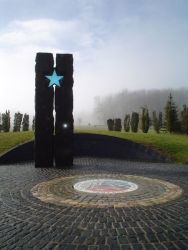Wolfe's Pond Park
North Forest and Acme Pond
The section of Wolfe’s Pond Park north of Hylan Boulevard is home to Acme Pond. Surrounding this freshwater pond is some of the most impressive woodland in New York City. Until the 1850s, most of this land was heavily farmed. All of the trees here sprouted after the farms were abandoned. As a result, the sweet gums (Liquidambar styraciflua) of the low wet areas and the white oaks (Quercus alba) and hickories (Carya) of the uplands are about the same age.
Today, remnants of sidewalks built in the 1920s are visible, constructed by speculators who anticipated several new housing developments to emerge in the area. Their plans came to an abrupt halt during the Great Depression and were never resuscitated. The scattered sidewalks and an occasional fire hydrant are the only reminders of their ambition.
Throughout the woods, vernal ponds appear in the spring, when snow melts and rain accumulates, only to evaporate in the summer heat. These ponds provide the ideal environment for trees like sweet gum, sour-gum (Nyssa sylvatica), red maple (Acer rubrum), and pin oaks (Quercus palustris), as well as ferns like cinnamon royal (Osmunda cinnamomea), and netted chain (Woodwardia areolata). Easily recognizable is swamp loosestrife (Decodon verticillatus), which turns bright red in the fall. Those plants that do not take well to the water will die, but in doing so provide feeding and nesting sites for downy woodpeckers (Picoides pubescens), green herons (Butorides virescens), and flickers (Colaptes auratus). Of particular value to the birds are the many insect larvae that attach to the leafless trees.
White oak and hickory dominate the drier sections of the forest. Wild lily-of-the-valley (Maianthenum canadense) provides a deep green carpet for the forest floor. Spots of wild sarsaparilla (Aralia nudicaulis), sassafras (Sassafras albidum), spicebush (Lindera benzoin), and wild mushrooms (Agaricales) add specks of color throughout, particularly after gentle summer rains. Garter snakes (Thamnophis), chipmunks (Tamias striatus), eastern gray squirrels (Sciurus carolinensis), wood thrushes (Hylocichla mustelina), brown thrashers (Toxostoma rufum), and American toads (Bufo americanus) all thrive under the leaves of this forest.
Acme Pond formed during the final stages of the last ice age. As the Wisconsin ice sheet retreated north 12,000 years ago, large chunks of ice dug holes into the earth and were sometimes left behind. As they melted, they created depressions resulting in kettle ponds such as this one. Acme Pond is heavily protected from human disturbance by the tangled growth of invasive species surrounding it, such as catbrier (Smilax rotundifolia) and multiflora rose (Rosa multiflora), but these species can out-compete the native vegetation, strangling trees, shrubs, and other essential wildlife habitat. In the swampy areas, skunk cabbage (Symplocarpus foetidus), tussock sedge (Carex stricta), and cinnamon fern thrive. The aquatic life of the pond is especially interesting. Brightly colored painted turtles (Chrysemys picta) and large snapping turtles (Chelydra serpentina) bask in the sunny areas of this pond, while red-backed salamanders (Plethodon cinereus) can be found hiding in the damp shade under logs near the pond’s edge.
Check out your park's Vital Signs
Clean & Safe
Green & Resilient
Empowered & Engaged Users
Share your feedback or learn more about how this park is part of a
Vital Park System










